
In 2024, A Step-by-Step Guide on Using ADB and Fastboot to Remove FRP Lock on your Google Pixel 8 Pro

A Step-by-Step Guide on Using ADB and Fastboot to Remove FRP Lock on your Google Pixel 8 Pro
Factory Reset Protection is one of the security measures available on Android 5.1 and later devices to prevent intruders’ unauthorized factory resetting of the Google Pixel 8 Pro device. Among the several ways to fix this issue and remove the lock, one is ADB and Fastboot commands. So, if you are aware of using Android Debug Bridge, the below content will help you understand how it can be used to remove the FRP lock.
You can watch the video below to bypass FRP lock without hassle!
Part 1: Quick Overview of ADB and Fastboot Commands
1. What are ADB and Fastboot?
Standing for Android Debug Bridge, ADB and Fastboots are the methods through which communication with an Android device can be done through a computer. Under this method, the commands and the actions that are sent from the system are performed on your Android device.
Several issues can be resolved, and multiple functions can be performed using the ADB format tool and Fastboots, and this also includes removing the FRP lock on your Android device. To use this method, USB debugging should be enabled on the Google Pixel 8 Pro device.
For specific brands of Android phones, specific utility tools are available like the Vivo ADB format tool and the Samsung ADB format tool, which are used explicitly for Vivo and Samsung phones, respectively.
2. How Do ADB and Fastboot Bypass FRP?
Using the versatile ADB command-line tool and Fastboots, the Google FRP lock can be removed using several commands depending on the OS version. This is a client-server program that includes a client who sends the commands, a daemon used to run the commands on the Google Pixel 8 Pro device, and a server that facilitates communication between the client and the daemon.
ADB comes included in the Android SDK Platform-Tools package, and this can be downloaded using the SDK manager.
3. What Are the Android Versions that ADB and Fastboot Command Support?
The Android versions on which ADB and Fastboot commands can be used are as follows:
_Android 5 – Lollipop__Android 6- Marshmellow__Android 7 – Nougat__Android 8- Oreo__Android 9- Pie__Android 10 – Q (expected to work though not tested as yet)_
Part 2: How to Set Up ADB and Fastboot Commands to Remove FRP Lock on Android?
To remove FRP lock using ADB, you first need to install and set up ADB and then remove them using the command. The steps for the same are enlisted below.
Steps to remove FRP using ADB

Step 1. Firstly, download the ADB installed setup file and then extract the files from the toolkit on your system in a folder.
Step 2. Next, you need to run adb.setup.exe and then type Y for installing the drivers for ADB and Fastboot.
Step 3. Again, enter Y for installing the drivers and when done successfully, the command window will close.
Step 4. Next, power on your Android device and connect it to your PC using a USB cable. Here also ensure that USB debugging mode is enabled on your Android device.
Step 5. Next, hold down the Shift key and then right-click at any place blank in the ADB folder, and then choose the Open command window here option.
Step 6. Now to remove the FRP you need to enter the following commands at the command prompt one by one where enter needs to be clicked after every line.
_Adb shell am start -n com.google.android.gsf.login/__adb shell am start -n com.google.android.gsf.login.LoginActivity__adb shell content insert –uri content://settings/secure –bind name:s:user_setup_complete –bind value:s:1_Step 7. The above commands are for Samsung devices. If you want to remove the FRP on other brands, enter the following commands:
_Adb shell content insert –uri content://settings/secure –bind__name:s:user_setup_complete –bind value:s:1_

After the execution of the commands, the FRP lock will be removed from your Android device.
Steps to remove FRP using Fastboot
Step 1. Put the Android device into the bootloader or fastboot mode. (depending on the model and brand of your Android device, the process of entering into the fastboot will differ).
Step 2. Connect your phone to your PC using a USB cable.
Step 3. Next, depending on the system, enter the following command in the CMD window:
_Lenovo FRP command__fastboot erase config__fastboot reboot__XIAOMI FRP command__fastboot -w__MICROMAX YU YUPHORIA FRP__Fastboot -i 0x2a96 erase configFastboot -i 0x2a96 reboot__DEEP/HTC/Other Brands FRP__fastboot erase configfastboot reboot_
Part 3: Limitations of Using ADB and Fastboot Command Method
The ADB and Fastboots command is a workable solution for removing the FRP lock on your Android device, the drawback is that the method is quite complicated and requires thorough technical know-how of ADB and its working. There are several limitations associated with this method as enlisted below.
- Requires technical know-how
To remove FRP using the ADB command you need to have a thorough knowledge of using the tool. The tool has a deep learning curve which makes this method little for the majority of the users.
- Might not unlock the phone
You can try the ADB method for removing the FRP lock but there is no guarantee that the results will be positive and your device will be unlocked.
- Issues with the drivers
Several times while using this method, you might encounter driver issues when your device is not detected as proper drivers are not installed.
- Unexpected issues and errors
ADB is a command-based method, and thus it is important that the commands are entered right. If there is a slight error in the typing of the command, it might lead to major issues and can even be the Google Pixel 8 Pro device damaged.
- The process is not user-friendly
ADB is a technical process aimed toward the geeks, and thus the overall process is not user-friendly and complicated.
Part 4: The Best ADB Alternative to Bypass FRP Lock on Android Phones
Considering the several limitations of the ADB and Fastboot command method, the need for a simple, user-friendly, and workable solution for removing FRP lock on Android devices arises. One of the best software here that we recommend is Dr.Fone - Screen Unlock (Android) which helps in removing and bypassing many Android phone screen locks including the one appearing due to FRP lock.
Dr.Fone - Screen Unlock (Android)
Remove Google FRP on Samsung without PIN code or Google accounts.
- Pattern, PIN, password, fingerprints & face screen lock can all be unlocked.
- Bypass Google FRP on Samsung without pin code or Google accounts.
- No tech knowledge asked, everybody can handle it.
- Work for Samsung, Xiaomi, Redmi, OPPO, etc.
4,005,551 people have downloaded it
The process of using the software is user-friendly and thus can also be used by non-techy users.
Steps for removing FRP lock on Android using Dr.Fone Screen Unlock
- Step 1. Launch the installed software and choose the Screen Unlock option from the main interface. Choose Android and then select the Remove Google FRP Lock option.

- Step 2. Select the model brans from the options shown on the interface, and then connect your phone to your PC using a USB cable. The connected device details will appear on the interface.
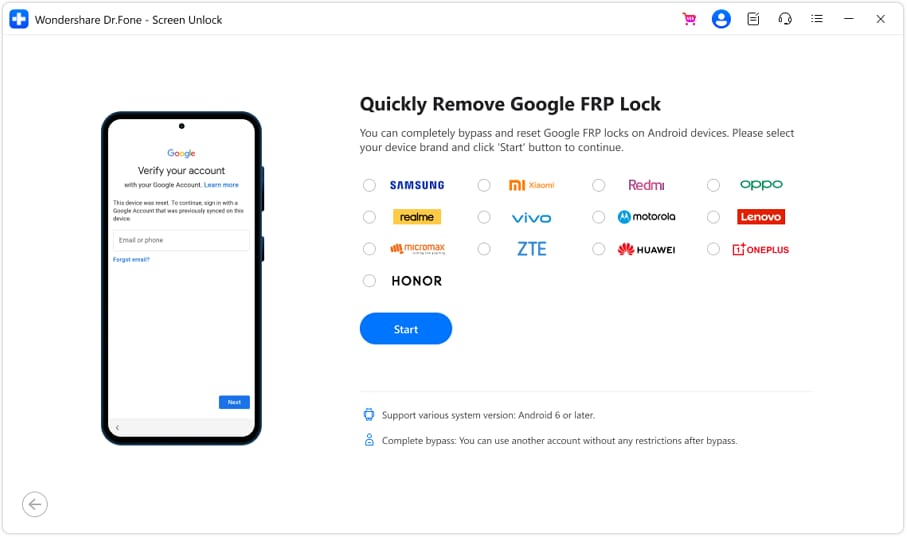
- Step 3. Follow the next steps as they appear. Once the FRP lock is successfully removed, the prompt window will show its completion. Click Done if you have successfully executed the process.
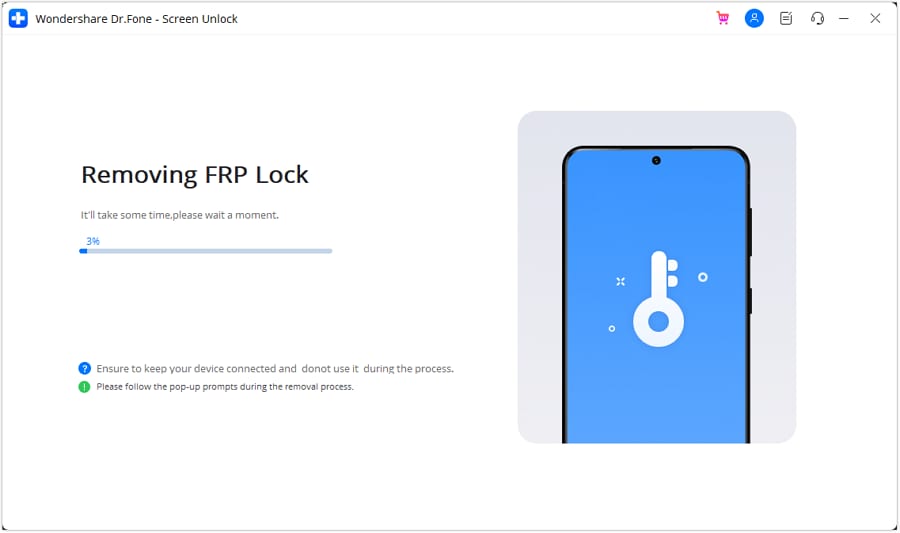
The above is the brief steps for the process. You can check the bypass Samsung FRP lock guide in detail.
Conclusion
If you are well versed with the commands of ADB and Fastboots you can go ahead and use the ADB bypass FRP tool for removing the FRP lock but if this command line method seems complicated for you, Dr.Fone Screen Unlock is the best tool to use.
How to Bypass Google FRP Lock on Google Pixel 8 Pro Devices
Technological advancements in the IT and telecommunication industry simplify your tasks and provide security against cyber malpractices. The advantages are numerous and appealing, but there are downsides too. One such inconvenience is caused by Google FRP lock in Google Pixel 8 Pro smartphones. The facility keeps your device information safe against unauthorized access. However, users often report issues like lockouts not being removed due to several causes. Such scenarios raise the demand for Google Pixel 8 Pro Nord FRP bypass solutions for seamless device access.
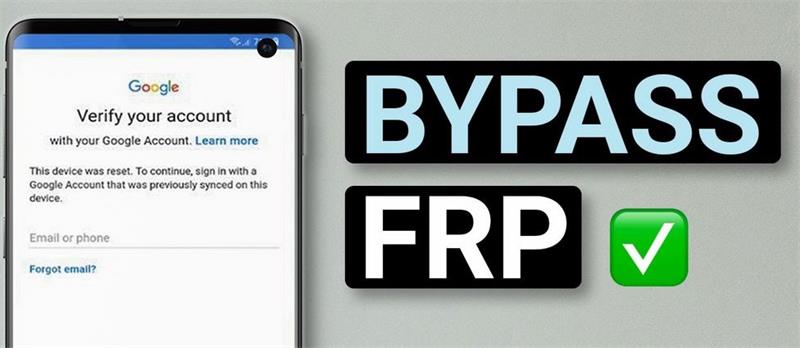
Part 1. What Is Google FRP and How Does It Work?
Google Factory Reset Protection (FRP) is an in-built security function in Android 5.1 and later versions. The feature protects these devices against intentional data loss on unauthorized access. The utility does not allow a factory reset of your device in case it is lost or stolen. Your data is hence, safe from unwanted mishandling. The feature also protects the Google Pixel 8 Pro device’s data encryptions and screen locks. The functionality gets enabled when you register a Google account on your Android device. As is obvious, the feature gets disabled when the Google account is removed before beginning the Factory Data Reset process.
If your device is under untrusted access and the FRP lock is enabled, the latter will prevent the factory reset of your phone. It is because; the active FRP lock requires entering the Google account credentials registered with the Google Pixel 8 Pro device. Therefore, unwanted users will not be possible to factory reset the Google Pixel 8 Pro phone. However, there may be instances when you need to factory reset your FRP-enabled device to its default settings. Ensure that the registered Google account credentials are available to you under such circumstances.
Part 2. How to Remove Google FRP Lock on Any Google Pixel 8 Pro Phone?
To remove the Google FRP lock on your Google Pixel 8 Pro device, you can follow any of the methods discussed below:
1. Bypass Google FRP Lock on Your Google Pixel 8 Pro Phone
- Switch on the Wi-Fi network of the Google Pixel 8 Pro phone and head to the ‘Hello’ screen.
- Take the following path:
Emergency Call> Emergency Rescue> Add Contact

- When the permission prompt pops up, click on ‘Deny’ and tap “Go to Settings”.
- Hit the ‘Permission’ tab and tap the ‘Search’ button.
- Enter ‘Settings’ in the search field, choose the ‘Settings App Info’ option, and tap the ‘Open’ button.
- Take the path given below to enable the system shortcuts:
System> Accessibility> Accessibility Menu> Toggle the Button to Turn it On> Allow> Got it
- Head to the “Settings” app and tap “Apps and Notifications”. Next, click on “See All Apps”.
- Find and disable the ‘Android Setup’ and ‘Google Play Service’ within the application list.

- Navigate back to the ‘Hello’ screen to completely disable the setup by taking the following path:
Start> Agree> Agree> Skip> Don’t Copy> Ok> Agree
- Skip the ‘Set Screen Lock’ task for completing the setup.
2. Using FRP Bypass APK
This is a quick and smart way to address the FRP lock removal issue within several minutes. Here’s what you need to do:
- Download the FRP Bypass APK to a PC or some other smartphone from the latter’s official website, followed by copying it into a pen drive.
- Use an OTG to connect the pen drive to the FRP-locked device.
- Head to the destination folder of the downloaded APK in the “File Manager” application.
- Install the APK in the FRP-locked phone by allowing the app permissions.
- Navigate to ‘Settings’ and enable the ‘Install from Unknown Source’ option.
- Reinstall and open the APK.
- The ‘Settings’ menu will pop up. Head to the “Backup and Reset” option.
- Click on ‘Factory Data Reset’, followed by “Erase Everything”.
- Tap ‘Confirm’ to erase all the Google Pixel 8 Pro device data.
- Register with a new Google account to use the phone.

3. Deactivate FRP in Your Google Pixel 8 Pro Phone
Removing the Google FRP lock using a computer is impossible in some instances. Deleting your registered Gmail account from the Google Pixel 8 Pro device can help you in these circumstances. The downside of this method is that your device’s data will lose protection from Google. Here’s how you can delete your Gmail account from the FRP-locked phone:
- Launch the “Settings” app on your Google Pixel 8 Pro device.

- In the app’s opening interface, click on the ‘Accounts’ tab to open the section.

- A list of all the accounts linked to your Google Pixel 8 Pro device will be displayed. Tap on the desired Gmail account to unlink it from your phone.

- The device data linked with the selected account will appear on the screen. Click on ‘Remove Account’ to proceed further.

- A confirmation prompt will pop up to ensure a willful deletion of the account from the Google Pixel 8 Pro device. Tap on ‘Remove Account’ to confirm the action. This will cause all data linked with the account to get deleted from the phone.

FAQs about Google Lock Bypass
1. Does Factory Reset Remove Google Account?
There may be instances when you require wiping out smartphone data to keep it safe against unauthorized access. Maybe you wish to pass on your device to another user or migrate to a different device. It is important to make sure that all accounts linked to the phone are deleted from the Google Pixel 8 Pro device. It should be understood here that a factory reset will not remove Google or other accounts from the Google Pixel 8 Pro device. The process restores the default factory settings of the phone that you got at the first purchase.
2. How to Enable Factory Reset Protection?
Enabling the Factory Reset protection feature is a smart way to protect the important data on your phone. However, issues of unethical access in cases of theft or loss are quite prominent. You can enable the FRP functionality by taking the following steps:
- When using a new device, sign in to the phone with your Google account. You can use an existing account or create a new one.
- Set a pattern or password screen lock on your device. It is not advisable to use swipe unlock or leave the phone unlocked at all. If you forget the pattern or password, Google credentials can be used to unlock the Google Pixel 8 Pro device.
These steps will cause the automatic configuration of the Factory Reset Protection feature. The invader will be prompted to enter the registered Google account credentials on every attempt to access the phone.
Conclusion
Developments in electronic technology have brought a series of benefits, covering easy access, security, and everything in between. One such feature is the Google Factory Reset Protection to protect your device data against untrusted access. The feature is undoubtedly credible, but there may be situations that require bypassing the FRP lock. For affordable solutions to address the concern on Google Pixel 8 Pro phones, pick the one that corresponds to your specific situation.
Dr.Fone - Screen Unlock (Android)
Unlock Your Google Pixel 8 Pro Phone in a Flash
Remove 5 screen lock types: pattern, PIN, password, ingerprints & Face ID.
Bypass Android FRP lock without a PIN or Google account.

Unlock mainstream Android brands like Samsung, Huawei, LG, Xiaomi, etc.
No tech knowledge required, Simple, click-through, process.
3,981,454 people have downloaded it
FRP Hijacker by Hagard: Download and Bypass your Google Pixel 8 Pro FRP Locks
If you find yourself locked out of your Android device after a factory reset, chances are your device is locked and protected by factory reset protection (FRP). FRP is a security feature devised by Google to deter unauthorized usage of a device after it undergoes a reset to its factory settings.
For those seeking a reliable solution, FRP Hijacker by Hagard emerges as a popular choice. This tool provides a streamlined approach to bypass FRP and regain control of your Android device. But before you start using it, we’ll provide you with all the essential information you need before utilizing this tool.

Part 1. Bypass FRP Using FRP Hijacker by Hagard: An Overview
FRP Hijacker by Hagard is a specialized tool designed to help users in bypassing the Factory Reset Protection (FRP) on Samsung phones. The app works with rooted and unrooted Android devices, taking advantage of system vulnerabilities.
Bypassing FRP with FRP Hijacker by Hagard is seamless and user-friendly—no tech skills needed. Just connect your phone to a computer, follow the on-screen steps, and within minutes, you’ll have access to your phone again. FRP Hijacker by Hagard is a quick and simple solution for anyone who forgot their Google account password.

List of features
- Dial Pad Bypass
By using the phone’s dial pad, this tool offers a special way to bypass FRP locks and makes the unlocking process more flexible.
- Hijack FRP with ADB Odin mode
FRP Hijacker offers the capability to bypass FRP in ADB Odin mode or download mode. ADB Odin mode is a dedicated pre-boot mode found on Samsung Galaxy smartphones and tablets.
- Easy ADB activation
The FRP Hijacker tool v1.0 simplifies the process of enabling ADB, allowing users to effortlessly activate Android Debug Bridge for seamless communication between devices to bypass the FRP.
Is It Safe to Use FRP Hijacker?
Using FRP Hijacker involves potential risks such as voiding the Google Pixel 8 Pro device warranty, legal implications, and compromising data security. Before proceeding, consider official alternatives from the Google Pixel 8 Pro device manufacturer, back up your data, and be aware of potential compatibility issues with updates.
Part 2. Download Link and How to Install FRP Hijacker by Hagard
To begin the FRP Hijacker installation process, start by downloading FRP Hijacker here. Then, make sure that your computer is equipped with the latest Microsoft .NET Framework.
Once both FRP Hijacker and Microsoft .NET Framework are ready, proceed with the following steps:
- Step 1: After the FRP Hijacker download, check the downloaded file. It will be in the form of a RAR file. Extract its contents and locate the .exe file.
- Step 2: Upon running the .exe file, you’ll be prompted to enter a password. The required password for FRP Hijacker can be found within the RAR file.
- Step 3: Follow the provided guidelines to finalize the installation process.

Part 3. How To Use FRP Hijacker by Hagard
Following the successful installation of FRP Hijacker by Hagard, proceed with the following steps to effectively use the tool and bypass the FRP in your device.
- Step 1: Once the installation is complete, connect your Android phone to the computer and run the FRP Hijacker application. Then, you will see a menu offering various options for managing your Samsung device.
- Step 2: From the menu, choose the specific Samsung device model you own.
- Step 3: Now, you will encounter two key options: ‘Remove FRP’ and ‘SoftBrick Fixer.’ To bypass FRP, select the ‘Remove FRP’ option.
- Step 4: After selecting ‘Remove FRP,’ click on the ‘HIJACK IT’ button. This action will trigger the tool to start the FRP removal process on your connected Samsung device.

As the tool progresses through the removal process, follow any additional on-screen prompts or instructions that may be provided. Once completed, your Samsung device should be successfully free from the FRP lock, granting you full access to its functionalities.
Part 4. Alternative Solution to FRP Hijacker by Hagard - Wondershare Dr.Fone
If you’re exploring alternatives to FRP Hijacker by Hagard, especially for non-Samsung Android devices, or if you simply prefer a different approach, Wondershare Dr.Fone provides a reliable and widely trusted solution in Android device management and recovery.
Dr.Fone offers the Screen Unlock tool, which is designed to address various Android device issues, including FRP lock situations. Here are key features that make it a noteworthy alternative:
- Fone supports iOS and 2000+ Android device models, making it versatile for users with different smartphone brands.
- Fone prioritizes data integrity. During the FRP unlocking process, Dr.Fone ensures minimal to no data loss, preserving your important files and information.
- Unlock Android devices with forgotten screen lock credentials
How to bypass FRP with Dr.Fone Screen Unlock feature
- Step 1: Launch Dr.Fone Screen Unlock and connect Android device.
Launch Wondershare Dr.Fone on your computer and connect your Android devices. Go to Toolbox > Screen Unlock.

- Step 2: Select Remove Google FRP Lock.
On the next screen, choose Android as your device type and select Remove Google FRP Lock to proceed.

- Step 3: Select the Android device model.
Pick your Android device model and click Start to proceed.

- Step 4: Choose the Android version.
Now, specify your Android version. If you’re unsure about the Android OS version on your Android or prefer the quickest method to eliminate the Google Lock, select the All Android versions (One-Click Removal) option. Continue by clicking the Start button.
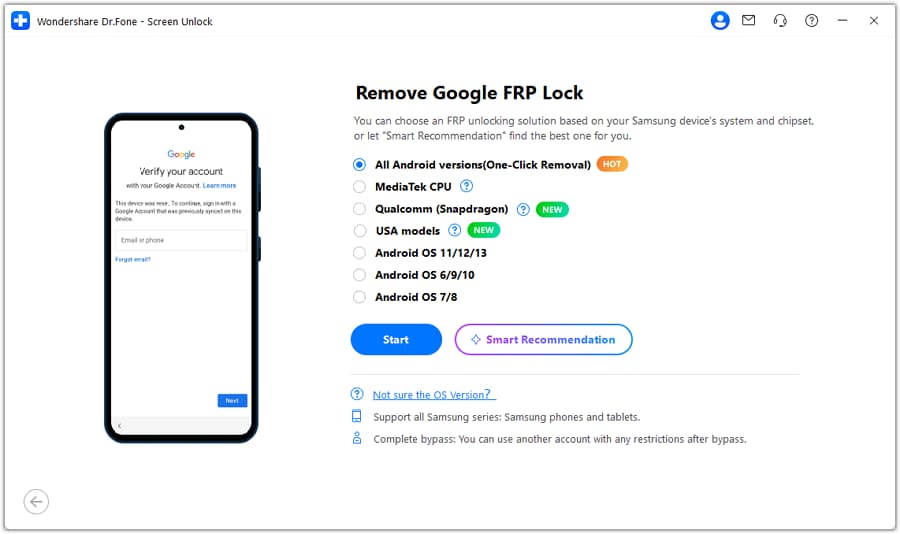
- Step 5: Open emergency call.
Follow on-screen instructions to open Emergency Call on your Android. Tap #0# to open a secret menu and click Next on your computer.
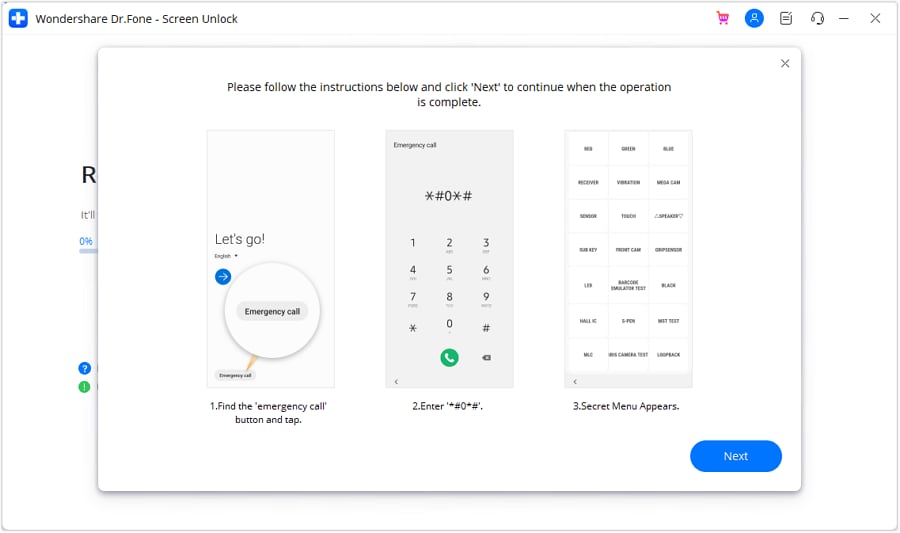
- Step 6: Enable USB debugging.
Enable USB Debugging on your Android when prompted. Click Authorized on your computer. The screen will confirm FRP lock removal.

Once you have successfully removed the FRP lock, click Done.
Part 5. FRP Hijacker by Hagard or Wondershare Dr.Fone: Which Is Better?
Now faced with the choice between FRP Hijacker by Hagard and Wondershare Dr.Fone, it becomes important to determine which tool aligns best with your specific requirements. Both options promise FRP bypass capabilities, yet they differ in their costs, ease of use, compatibility, and security measures.
Let’s delve deeper into each tool’s strengths and weaknesses.
| Hijacker by Hagard | Dr.Fone – Screen Unlock | |
|---|---|---|
| Ease of use | Simple and straightforward | Intuitive design with a guided process |
| Security Measures | Using vulnerabilities in the Android operating system to bypass FRP | High encryption and protection measures during the FRP unlocking process |
| Compatibility | Primarily for Samsung devices | Compatible with a wide range of Android and iOS devices. |
| Cost | Generally free | Paid software with a free trial |
| Support and Updates | Limited support; updates may vary | Strong customer support; regular updates |
Conclusion
FRP Hijacker by Hagard presents itself as a targeted solution, particularly effective for Samsung devices. Its simplicity and specialized approach make it an appealing option for users who prioritize ease of use and have Samsung smartphones. However, it’s important to note that its effectiveness is confined to Samsung devices, and users should consider this limitation when making a decision.
For those using Android devices other than Samsung or desiring a more versatile solution, Dr.Fone’s Screen Unlock tool proves effective and easy to use. Just pick the one that matches your device and preferences for a smooth FRP unlocking experience.
Tips: Are you searching for a powerful FRP Unlock tool? No worries as Dr.Fone is here to help you. Download it and start a seamless unlock experience!
Also read:
- [Updated] Crafting Visual Harmony with Bokeh Techniques in Storytelling
- [Updated] In 2024, Innovative Online Services for Crafting Perfect Facebook Covers
- 2024 Approved Capturing Closer Action Tips for Zooming In on Videoleap
- 3 Things You Must Know about Fake Snapchat Location On Motorola Edge 40 Pro | Dr.fone
- Complete Guide to iPhone-to-iPhone Transfer App: Easily Move Files Onto Your Computer or Android Phone
- Honor V Purse ADB Format Tool for PC vs. Other Unlocking Tools Which One is the Best?
- How to Bypass Google FRP Lock on Honor Magic 5 Pro Devices
- In 2024, 5 Solutions For Nubia Red Magic 8S Pro Unlock Without Password
- In 2024, FRP Hijacker by Hagard Download and Bypass your Itel P55+ FRP Locks
- In 2024, Full Guide to Bypass Honor Magic5 Ultimate FRP
- Step-by-Step Tutorial How To Bypass Infinix Zero 5G 2023 Turbo FRP
- Ultimate Tutorial for Executing a Password-Free Restore on Windows 11 Computers in Factories
- Vivo Y27 4G ADB Format Tool for PC vs. Other Unlocking Tools Which One is the Best?
- Title: In 2024, A Step-by-Step Guide on Using ADB and Fastboot to Remove FRP Lock on your Google Pixel 8 Pro
- Author: Lynn
- Created at : 2024-10-31 08:49:25
- Updated at : 2024-11-06 20:37:15
- Link: https://bypass-frp.techidaily.com/in-2024-a-step-by-step-guide-on-using-adb-and-fastboot-to-remove-frp-lock-on-your-google-pixel-8-pro-by-drfone-android/
- License: This work is licensed under CC BY-NC-SA 4.0.
